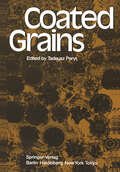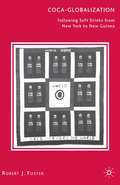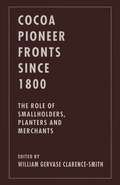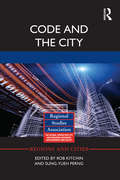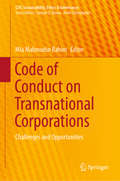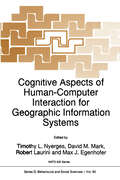- Table View
- List View
Coasts: Coasts Library Ebook (Popcorn: Geography Corner)
by Ruth ThomsonDiscover the world's most beautiful coastlines. Find out about waves and tides, rockpools and rocky cliffs, beaches and dunes, sea birds and animals, harbours and ports and how people are protecting coasts.
Coasts: Form, Process And Evolution (PDF)
by Colin D. WoodroffeCoasts are some of the most rapidly changing places on earth. Understanding the natural adjustments that occur between coastal landforms and the processes that influence them is essential for the better management of coastal resources. Coasts provides a necessary background in geomorphology for those studying coastal systems. It describes the landforms that occur on the coast, their responses to the processes that shape them, and the pattern of evolution that can be determined for different types of coast over thousands of years. Numerous examples from around the world are used to illustrate the variety of environments. Particular attention is paid to coastal morphodynamics, the co-adjustment of process and form, on rocky, reef, sandy, deltaic-estuarine and muddy coasts. This valuable text for advanced undergraduate and graduate students is well illustrated and contains an extensive reference section. I
Coasts, Estuaries and Lakes: Implications for Sustainable Development
by N. Jayaraju G. Sreenivasulu M. Madakka M. ManjulathaThis volume discusses geological, biological and sustainability aspects of coastal, estuary and lake environments. It offers a comprehensive understanding of biotic, physico-chemical, sedimentological and socio-environmental factors associated with the sustainable development of these environments in areas vulnerable to climate change and other anthropogenic activities. The book is divided into several main sections, covering the geological and biological processes and dynamics of these environments, water quality and hydrological modeling, sediment characteristics, bio-indicators and ecological analysis, climate change impacts, geospatial applications, and sustainable development practices and scenarios. The book aims to be a useful resource for academics, scientists, coastal and marine practitioners, meteorologists, environmental consultants and computing experts working in the areas of earth and ocean sciences.
Coated Grains
by DrCoated grains have always attracted attention, at first of naturalists, and later of geologists, and the interest in these peculiar bodies was re lated both to their intriguing form and their significance in facies inter pretation and sedimentology and to their relevance to accumulations of hydrocarbons and other mineral deposits. This resulted in numerous publications on this subject, and the intention of this volume is to sum marize the present state of knowledge on coated grains. The idea of the book was to unite some general papers with papers reporting case studies of both recent and ancient coated grains. The organization of the book follows this intention. The papers presented in this volume have been invited by the editor; the theme of the book merits a few words of personal history. The development of studies of coated grains during the last two decades has not only resulted in a great increase in knowledge of recent and ancient environments of coated grain formation, but also numerous important and controversial questions of classification, environmental significance, mineralogical composition etc. of ancient coated grains have arisen. To answer these questions, in 1978 I started the study of many ancient and recent occurrences of coated grains at the Institut fUr Geologie, Ruhr-UniversiUH Bochum, following the invitation of Hans Fiichtbauer and sponsored by the Alexander von Humboldt-Stiftung.
Coca-Globalization: Following Soft Drinks from New York to New Guinea
by R. FosterThis book explores globalization through a historical and anthropological study of how familiar soft drinks such as Coke and Pepsi became valued as more than mere commodities. Foster discusses the transnational operations of soft drink companies and, in particular, the marketing of soft drinks in Papua New Guinea, a country only recently opened up to the flow of brand name consumer goods. Based on field observations and interviews, as well as archival and library research, this book is of interest to anyone concerned about the cultural consequences and political prospects of globalization, including new forms of consumer citizenship and corporate social responsibility.
Coccolithophores: From Molecular Processes to Global Impact
by Hans R. Thierstein Jeremy R. YoungThis introduction to one of the most common phytoplankton types provides broad coverage from molecular and cellular biology all the way to its impact on the global carbon cycle and climate. Individual chapters focus on coccolithophore biology, ecology, evolutionary phylogeny and impact on current and past global changes. The book addresses fundamental questions about the interaction between the biota and the environment at various temporal and spatial scales.
Cocoa
by G. A. Wood R. A. LassThe fourth edition of this highly regarded book has been considerably enlarged to cover all aspects of cocoa production. Higher prices for cocoa have led to much new knowledge about the plant and changes to its methods of production. These are discussed, along with new problems that have occurred and the fresh research projects that have been needed.
Cocoa Pioneer Fronts since 1800: The Role of Smallholders, Planters and Merchants
by William Gervase Clarence-SmithThe livelihood of Third World farmers conflicts with saving the remaining tropical forests. The advantages of growing cocoa in cleared primary forest drive from the fertility of virgin soils and low concentrations of weeds, pests and diseases. The consequent emergence of new 'pioneer fronts' has also been affected by cheap labour, relative commodity prices, pests and diseases, credit resources, entrepreneurship, information, physical infrastructures, and government policies. The dynamism of smallholdings and competitive private marketing over estates and marketing boards is demonstrated.
The Coconut: Botany, Production and Uses (Botany, Production and Uses)
by E. A. Aguilar J. Alouw F. C. Beveridge M. A. Bezerra R. Bhat R. Cave K. Chapman R. Dakshayani F. M. Dayrit P. D. Dissanayake H. R. Gheyi K. B. Hebbar V. B. Johnson Sundaravelpandian Kalaipandian S. Karouw A. C. Khanashyam E.Y.Y. Kong C.F.D. Lacerda J. C. Lacsina M. R. Manikantan E. C. Manohar Z. Mu M. Narváez M. F. Neto Q. T. Nguyen C. Oropeza C. F. Ortiz R. Pandiselvam B. Panis A. Peña L. Perera S. Periasamy S. Rajkumar M. Ramaswamy S. V. Ramesh E. Ramos N. Satyaseelan C. Silverio S. Sisunandar P. Subramanian P. A. Sukumar R. S. Veluchamy V.R.M. Vidhanaarachchi H. Wilms C. YangThe coconut palm (Cocos nucifera L.) is one of the world's most important palms, and contributes significantly to the income and livelihood of many people in tropical countries. Widely referred to as the 'tree of life', coconut has been used as a source of food, drink, oil, medicine, shelter and wood for around 500 years. Every part of the coconut palm can be utilized. The demand for coconut fruit and its products has increased recently as people have become aware of its nutritional and health benefits, especially those of coconut water and virgin coconut oil. This book covers all aspects of coconut including origins and diversity; ecophysiology; production in a changing climate; pests and diseases; harvest and postharvest management; breeding and genetics; as well as the current and future status of coconut as an economic crop. This book is a key resource for researchers and students in horticulture, plant science and agriculture, and those interested in the production of tropical crops, and practitioners in the coconut industry.
The Coconut Palm (Cocos nucifera L.) - Research and Development Perspectives
by K. U. Nampoothiri V. Krishnakumar P. K. Thampan M. Achuthan NairSince the publication of "The coconut palm - A monograph" in 1960, considerable information has been accrued on the crop through work at research institutes, international organisations and development agencies. Although coconut cultivation is spread over 93 countries, providing employment and creating livelihood opportunities to 64 million families around the globe, smallholder coconut farmers are now facing numerous challenges. The wide gap between the potential and actual yield is a major concern, and as such it is necessary to disseminate knowledge in order to implement research findings. Coconut research in India, one of the leading coconut producing countries, is celebrating its centenary, making this an opportune time to review the research and development advances and the relevant technologies. This detailed, comprehensive book covers all aspects of coconut, from the origins to cultivation, breeding, physiology and value addition, as well as subjects of topical interest like nutrition and health, biotechnology, and climate change and carbon sequestration. Written by leading experts in the fields it emphasises that the livelihood of the small coconut landholders is the ultimate aim of scientists and developmental agencies, and outlines various important strategies to make coconut farming more remunerative globally. It discusses work in all the major coconut growing countries and outlines suggestions for international cooperation.Research work on the crop is comparatively difficult because of its perennial nature, longevity, height, long juvenile phase, large sized nuts, cross pollination and seed propagation. As these special features necessitate greater investment of resources, time and land, it is all the more imperative that research is not duplicated and the information and experience becoming available around the world is shared so that it can be fully utilised. In this context periodic publications, compiling all the available information on coconut assume greater significance. This book is therefore of great value to researchers, students, extension workers, developmental agencies and progressive farmers.
Code and the City (Regions and Cities)
by Rob Kitchin Sung-Yueh PerngSoftware has become essential to the functioning of cities. It is deeply embedded into the systems and infrastructure of the built environment and is entrenched in the management and governance of urban societies. Software-enabled technologies and services enhance the ways in which we understand and plan cities. It even has an effect on how we manage urban services and utilities. Code and the City explores the extent and depth of the ways in which software mediates how people work, consume, communication, travel and play. The reach of these systems is set to become even more pervasive through efforts to create smart cities: cities that employ ICTs to underpin and drive their economy and governance. Yet, despite the roll-out of software-enabled systems across all aspects of city life, the relationship between code and the city has barely been explored from a critical social science perspective. This collection of essays seeks to fill that gap, and offers an interdisciplinary examination of the relationship between software and contemporary urbanism. This book will be of interest to those researching or studying smart cities and urban infrastructure.
Code and the City (Regions and Cities)
by Rob Kitchin Sung-Yueh PerngSoftware has become essential to the functioning of cities. It is deeply embedded into the systems and infrastructure of the built environment and is entrenched in the management and governance of urban societies. Software-enabled technologies and services enhance the ways in which we understand and plan cities. It even has an effect on how we manage urban services and utilities. Code and the City explores the extent and depth of the ways in which software mediates how people work, consume, communication, travel and play. The reach of these systems is set to become even more pervasive through efforts to create smart cities: cities that employ ICTs to underpin and drive their economy and governance. Yet, despite the roll-out of software-enabled systems across all aspects of city life, the relationship between code and the city has barely been explored from a critical social science perspective. This collection of essays seeks to fill that gap, and offers an interdisciplinary examination of the relationship between software and contemporary urbanism. This book will be of interest to those researching or studying smart cities and urban infrastructure.
Code of Conduct on Transnational Corporations: Challenges and Opportunities (CSR, Sustainability, Ethics & Governance)
by Mia Mahmudur RahimThis book explores the challenges and opportunities presented by the formulation of a global code of conduct for transnational corporations. It assesses the current state of research on global regulations intended to enhance the social responsibility of transnational corporations, and provides a platform for future research. In particular the book examines frameworks and instruments for regulating social responsibility, reviews recent developments concerning the proposed UN Code of Conduct on Transnational Corporations, and provides insights into international civil society groups’ movements in pursuit of a code of conduct. In a separate chapter the book discusses theoretical issues in regulating transnational corporations, and investigates their legitimacy and behavioral dynamics. In closing, the book discusses alternatives to a global code of conduct, the impact of sovereign power in the era of globalization, “soft regulations,” and the feasibility and normative efficacy of enforcing regulations.
Coexistence and Confrontation of Agricultural and Food Models: A New Paradigm of Territorial Development?
by Sylvie ZasserThis book analyses situations of coexistence and confrontation of agricultural and food models according to four major dimensions of territorial development: the tension between specialisation and diversification; innovation; adaptation; and food transition. New agricultural and food models are being deployed in territories around the world in response to criticisms of the old forms of agriculture and food production, and in order to meet new challenges. These models embody archetypes of the observed diversity, actors’ projects or new norms. A number of conceptual studies and case studies from France and other countries allow us to understand the interactions between these models (confrontation, complementarity, co-evolution, hybridisation, etc.), taking us well beyond the characterisation of their diversity and the evaluation of their relative performances. The coexistence and confrontation of these models build up their capacity for radical change. The book asks original questions about the analytical framework, its methodological challenges and the expected outcomes for the support of agricultural and food development in rural and urban territories. It is intended for researchers, teachers, students and professionals interested in territorial development. Pierre Gasselin, Sylvie Lardon, Claire Cerdan, Salma Loudiyi and Denis Sautier are the scientific coordinators of this book. They are geographers and economists at CIRAD, INRAE and VetAgro Sup, where they conduct research on the transformation of agriculture, food systems and territories in France and other countries. This book is the result of a collective research process involving 36 authors from Argentina, Belgium, Brazil, Burkina Faso, France, Japan, Switzerland and Vietnam. Jan Douwe van der Ploeg, author of the Foreword, is Professor Emeritus of Rural Sociology at Wageningen University & Research in the Netherlands and Associate Professor of Agricultural Sociology at the China Agricultural University in Beijing. He has conducted extensive research on processes of agricultural transition and on dynamics of rural development.
Coffee: Recent Developments (World Agriculture Series)
by Ronald Clarke O. G. VitzthumCoffee, one of the most commercially important crops grown, is distributed and traded globally in a multi-million dollar world industry. This exciting new book brings together in one volume the most important recent developments affecting the crop. Contributions from around 20 internationally-respected coffee scientists and technologists from around the world provide a vast wealth of new information in the subject areas in which they are expert. The book commences with three cutting-edge chapters covering non-volatile and volatile compounds that determine the flavour of coffee. Chapters covering technology follow, including comprehensive information on developments in roasting techniques, decaffeination, the science and technology of instant coffee and home / catering beverage preparation. The physiological effects of coffee drinking are considered in a fascinating chapter on coffee and health. Agronomic aspects of coffee breeding and growing are covered specifically in chapters concentrating on these aspects, particularly focussing on newly-emerging molecular and cellular techniques. Finally, recent activities of some international organisations are reviewed in a lengthy appendix. The editors of Coffee: Recent Developments have drawn together a comprehensive and extremely important book that should be on the shelves of all those involved in coffee. The book is a vital tool for food scientists, food technologists and agricultural scientists and the commercially important information included in the book makes it a 'must have reference' to all food companies involved with coffee. All libraries in universities, and research stations where any aspect of the coffee crop is studied or taught should have copies of the book available. R. J. Clarke, also co-editor of the widely-acclaimed six-volume work Coffee published between 1985 and 1988, is a consultant based in Chichester U. K. O. G. Vitzthum, formerly Director of Coffee Chemistry Research worldwide at Kraft, Jacobs, Suchard in Bremen, Germany is Honorary Professor at the Technical University of Braunsweig, Germany and Scientific Secretary of the Association Scientifique Internationale du Cafe (ASIC), in Paris France.
Cognitive and Linguistic Aspects of Geographic Space (NATO Science Series D: #63)
by D. M. Mark Andrew U. FrankThis book contains twenty-eight papers by participants in the NATO Advanced Study Institute (ASI) on "Cognitive and Linguistic Aspects of Geographic Space," held in Las Navas del Maxques, Spain, July 8-20, 1990. The NATO ASI marked a stage in a two-year research project at the U. S. National Center for Geographic Infonnation and Analysis (NCOIA). In 1987, the U. S. National Science Foundation issued a solicitation for proposals to establish the NCGIA-and one element of that solicitation was a call for research on a "fundamental theory of spatial relations". We felt that such a fundamental theory could be searched for in mathematics (geometry, topology) or in cognitive science, but that a simultaneous search in these two seemingly disparate research areas might produce novel results. Thus, as part of the NCGIA proposal from a consortium consisting of the University of California at Santa Barbara, the State University of New York at Buffalo, and the University of Maine, we proposed that the second major Research Initiative (two year, multidisciplinary research project) of the NCOIA would address these issues, and would be called "Languages of Spatial Relations" The grant to establish the NCOIA was awarded to our consortium late in 1988.
Cognitive and Linguistic Aspects of Geographic Space: New Perspectives on Geographic Information Research (Lecture Notes in Geoinformation and Cartography)
by Martin Raubal, David M. Mark and Andrew U. Frank20 years ago, from July 8 to 20, 1990, 60 researchers gathered for two weeks at Castillo-Palacio Magalia in Las Navas del Marques (Avila Province, Spain) to discuss cognitive and linguistic aspects of geographic space. This meeting was the start of successful research on cognitive issues in geographic information science, produced an edited book (D. M. Mark and A. U. Frank, Eds., 1991, Cognitive and Linguistic Aspects of Geographic Space. NATO ASI Series D: Behavioural and Social Sciences 63. Kluwer, Dordrecht/Boston/London), and led to a biannual conference (COSIT), a refereed journal (Spatial Cognition and Computation), and a substantial and still growing research community. It appeared worthwhile to assess the achievements and to reconsider the research challenges twenty years later. What has changed in the age of computational ontologies and cyber-infrastructures? Consider that 1990 the web was only about to emerge and the very first laptops had just appeared! The 2010 meeting brought together many of the original participants, but was also open to others, and invited contributions from all who are researching these topics. Early-career scientists, engineers, and humanists working at the intersection of cognitive science and geographic information science were invited to help with the re-assessment of research needs and approaches. The meeting was very successful and compared the research agenda laid out in the 1990 book with achievements over the past twenty years and then turned to the future: What are the challenges today? What are worthwhile goals for basic research? What can be achieved in the next 20 years? What are the lessons learned? This edited book will assess the current state of the field through chapters by participants in the 1990 and 2010 meetings and will also document an interdisciplinary research agenda for the future.
Cognitive Aspects of Human-Computer Interaction for Geographic Information Systems (NATO Science Series D: #83)
by Max J. Egenhofer RobertLaurini David M. Mark Timothy L. NyergesA significant part of understanding how people use geographic information and technology concerns human cognition. This book provides the first comprehensive in-depth examination of the cognitive aspects of human-computer interaction for geographic information systems (GIS). Cognitive aspects are treated in relation to individual, group, behavioral, institutional, and cultural perspectives. Extensions of GIS in the form of spatial decision support systems and SDSS for groups are part of the geographic information technology considered. Audience: Geographic information users, systems analysts and system designers, researchers in human-computer interaction will find this book an information resource for understanding cognitive aspects of geographic information technology use, and the methods appropriate for examining this use.
Coherency Management: An Alternative to CSR in a Changing World
by Ivan HilliardThis book presents a new approach to corporate responsibility based on the concept of coherency, permitting better understanding and management of the conflicting forces that strive to create value across the stakeholder spectrum. In doing so, it provides an alternative to the limited and ineffective role currently played by Corporate Social Responsibility (CSR), and offers an approach more in line with the needs of a sustainable society. Hilliard introduces several new concepts in management philosophy and presents an innovative and original framework for managing organizational responsibilities in a coherent manner.
Coherent Dynamics of Complex Quantum Systems (Theoretical and Mathematical Physics)
by Vladimir M. AkulinCoherent Dynamics of Complex Quantum Systems is aimed at senior-level undergraduate students in the areas of atomic, molecular, and laser physics, physical chemistry, quantum optics and quantum informatics. It should help them put particular problems in these fields into a broader scientific context and thereby take advantage of the well-elaborated technique of the adjacent fields.
Coherent Evolution in Noisy Environments (Lecture Notes in Physics #611)
by Andreas Buchleitner Klaus HornbergerIn the last two decades extraordinary progress in the experimental handling of single quantum objects has spurred theoretical research into investigating the coupling between quantum systems and their environment. Decoherence, the gradual deterioration of entanglement due to dissipation and noise fed to the system by the environment, has emerged as a central concept. The present set of lectures is intended as a high-level, but self-contained, introduction into the fields of quantum noise and dissipation.In particular their influence on decoherence and applications pertaining to quantum information and quantum communication are studied, leading the nonspecialist researchers and the advanced students gradually to the forefront of research.
Coherent Flow Structures at Earth's Surface
by Jeremy G. Venditti James L. Best Michael Church Richard J. HardyAn expert review of recent progress in the study of turbulent flows with a focus on recently identified organized structures. This book reviews the recent progress in the study of the turbulent flows that sculpt the Earth’s surface, focusing in particular on the organized structures that have been identified in recent years within turbulent flows. These coherent flow structures can include eddies or vortices at the scale of individual grains, through structures that scale with the flow depth in rivers or estuaries, to the large-scale structure of flows at the morphological or landform scale. These flow structures are of wide interest to the scientific community because they play an important role in fluid dynamics and influence the transport, erosion and deposition of sediment and pollutants in a wide variety of fluid flow environments. Scientific knowledge of these structures has improved greatly over the past 20 years as computational fluid dynamics has come to play an increasing important part in building our understanding of coherent flow structures across a broad range of scales. Chapters comprise a series of major, invited papers and a selection of the most novel, innovative papers presented at the second Coherent Flow Structures Conference held August 3-5, 2011 at Simon Fraser University in Burnaby, British Columbia. Chapters focus on six major themes: Dynamics of coherent flow structures (CFS) in geophysical flows Interaction of turbulent flows, vegetation and ecological habitats Coherent structure of atmospheric flows Numerical modeling of coherent flow structures Turbulence in open channel flows Coherent flow structures, sediment transport and morphological feedbacks.
Coherent Flow Structures at Earth's Surface
by Jeremy G. Venditti James L. Best Michael Church Richard J. HardyAn expert review of recent progress in the study of turbulent flows with a focus on recently identified organized structures. This book reviews the recent progress in the study of the turbulent flows that sculpt the Earth’s surface, focusing in particular on the organized structures that have been identified in recent years within turbulent flows. These coherent flow structures can include eddies or vortices at the scale of individual grains, through structures that scale with the flow depth in rivers or estuaries, to the large-scale structure of flows at the morphological or landform scale. These flow structures are of wide interest to the scientific community because they play an important role in fluid dynamics and influence the transport, erosion and deposition of sediment and pollutants in a wide variety of fluid flow environments. Scientific knowledge of these structures has improved greatly over the past 20 years as computational fluid dynamics has come to play an increasing important part in building our understanding of coherent flow structures across a broad range of scales. Chapters comprise a series of major, invited papers and a selection of the most novel, innovative papers presented at the second Coherent Flow Structures Conference held August 3-5, 2011 at Simon Fraser University in Burnaby, British Columbia. Chapters focus on six major themes: Dynamics of coherent flow structures (CFS) in geophysical flows Interaction of turbulent flows, vegetation and ecological habitats Coherent structure of atmospheric flows Numerical modeling of coherent flow structures Turbulence in open channel flows Coherent flow structures, sediment transport and morphological feedbacks.
Coherent States and Applications in Mathematical Physics (Theoretical and Mathematical Physics)
by Monique Combescure Didier RobertThis book presents the various types of coherent states introduced and studied in the physics and mathematics literature and describes their properties together with application to quantum physics problems. It is intended to serve as a compendium on coherent states and their applications for physicists and mathematicians, stretching from the basic mathematical structures of generalized coherent states in the sense of Perelomov via the semiclassical evolution of coherent states to various specific examples of coherent states (hydrogen atom, quantum oscillator, ...).
Coherent States and Applications in Mathematical Physics (Theoretical and Mathematical Physics)
by Didier Robert Monique CombescureThis second edition of the outstanding monograph on coherent states by Combescure and Robert published in 2012 is enriched with figures, historical information and numerical simulations and enlarged with five new chapters presenting important rigorous results obtained in the recent years. The new chapters include various applications such as to the time dependent Schroedinger equation and the Ehrenfest time, to the growth of norms and energy exchanges, to chaotic systems and classical systems with quantum ergodic behavior, and to open quantum systems, and to adiabatic decoupling for multicomponent systems Overall, this book presents the various types of coherent states introduced and studied in the physics and mathematics literature and describes their properties together with application to quantum physics problems. It is intended to serve as a compendium on coherent states and their applications for physicists and mathematicians, stretching from the basic mathematical structures of generalized coherent states in the sense of Perelomov via the semiclassical evolution of coherent states to various specific examples of coherent states (hydrogen atom, quantum oscillator, etc.). It goes beyond existing books on coherent states in terms of a rigorous mathematical framework



